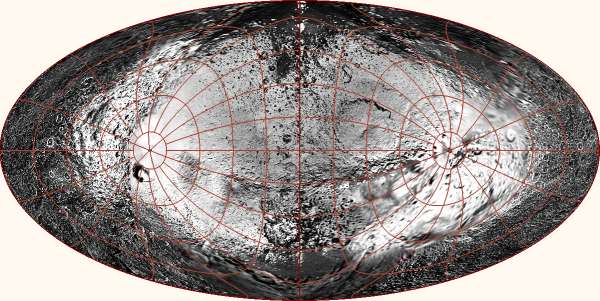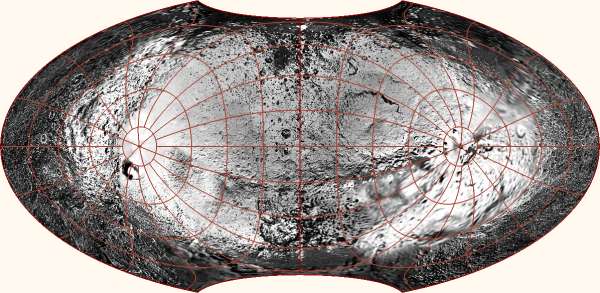Now that I have a program to draw world maps with nonstandard orientations, I could not resist turning it loose on this albedo map of Saturn's moon Iapetus, pieced together from images taken by the Voyager 2 (1981) and Cassini (2005-2007) spacecraft. Iapetus is one of the strangest objects in the solar system. Its most famous feature is its "two-tone coloration": it has a light side and a dark side, and is much brighter when the light side faces the sun (and us). But there is more strangeness than that; go read the Wikipedia article.
In the novel version of 2001: A Space Odyssey, Author C. Clarke explained away all the strangeness with a deus ex machina solution: the entire moon is an alien artifact! He warned, however that "the truth, as always, will be far stranger."
Here is an ordinary map, with the central meridian chosen to go through the middle of the dark area:

We see a large dark splotch (named Cassini Regio) on a light moon. On the other hand, Clarke relates in the introduction to 2010: Odyssey Two that Carl Sagan sent him a Voyager image showing a white oval on a dark moon. How can that be? Let's get out our planet tilter:

The edge of this map runs along the moon's equator, in the middle of Cassini Regio. Now we see a light splotch (called Roncevaux Terra) on a dark background. Magic!
I've cheated a bit, though, by choosing the little-used Aitoff's projection for the above maps; it exaggerates the size of areas near the edge of the map. With the equal-area projection I used for Earth in my earlier post, the Roncevaux Terra map may begin to look more like a light world with a dark edge:

Finally, a map with the poles in the centers of the light/dark areas:

The boundary between light and dark does not really divide the moon into hemispheres; it goes more like the seam on a baseball.



 Henning Makholm is a computer scientist and software developer living in Copenhagen, Denmark. Find out more about him on his
Henning Makholm is a computer scientist and software developer living in Copenhagen, Denmark. Find out more about him on his
No comments:
Post a Comment